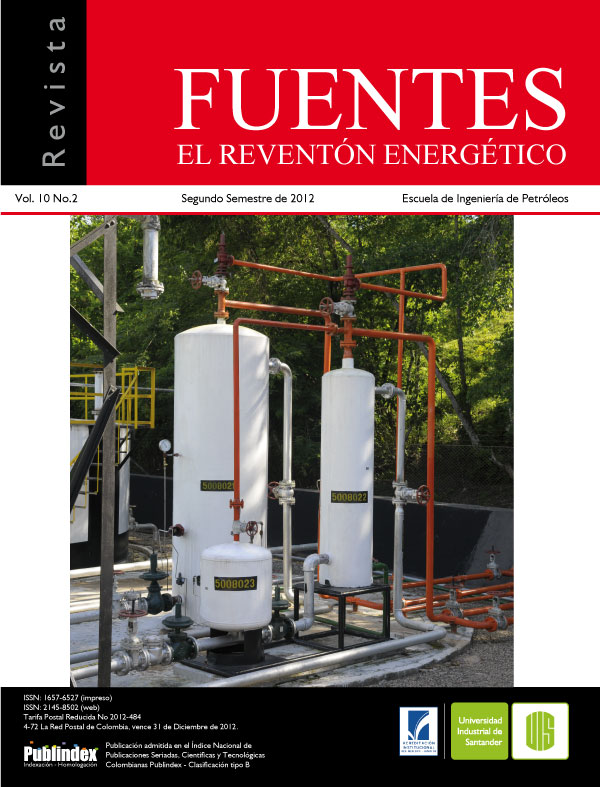Análisis de los gases de combustión - el verdadero rol de las pruebas de tubo
Published 2012-11-28
Keywords
- in situ,
- combustion,
- injection of air,
- breaking reactions.
How to Cite
Abstract
During and after a combustion tube test, when the post-core is disassembly and removed, the produced fuids are amalysed. The emulsions are analyzed by the addition of toluene and centrifugation. Each oil sample is analyzed to determine the viscosity and density. Also, the analysis of the water samples involves measurement of pH, total solids, total carbon and various cations and anions such as sulfates, carbonates, chlorides, magnesium, sodium and potassium.
The most important analysis in the tube test is the analysis of gases; this is done for the determination of stoichiometric parameters, involving the understanding of the reactions that occurred in the process. This is done with the help of the results given by chromatography, where the molar compositions of the compounds of the gas produced are determined. These results are processed to calculate the most important variables for evaluating the process. With these variables it is possible to compare tests done in laboratory to determinate whether they are successful or which is the operating temperature range.
Downloads
References
2. BELGRAVE, Jhon D. M., MOORE GORDON and BENNION DOUGLAS W. The thermal behavior of vertically operated near-adiabatic in situ combustion tubes. J. Pet. Sci. Eng. 5 (1990) 51-65.
3. BURGER, Jacques G., SAHUQUET, Bernard C. Institute Francais Petroleo. SPE 00004144. 1973.
4. CHICUTA, A.M., TREVISAN, O.V., UNICAMP. Experimental study on in-situ combustion of brazilian heavy oil. SPE 122036.
5. DIETZ, Daniel N., Review of Thermal Recovery Methods. Member SPE-AIME, Delft University of Technology. Paper SPE 5558.
6. E.S., Juan, SANCHEZ, A., A. DEL MONTE Repsol YPF R.G. MOORE, S.A. MEHTA, M.G. URSENBACH University of Calgary. Laboratory Screening for air injection-based IOR in Two Water flooded Light Oil Reservoirs. JCPT 1998.
7. GREAVES, M., DUDLEYT, J W O and R W Field. Factorial Experiments in In-Situ Combustion. University of Bath. SPE 19463.
8. GUERRA, Jose Julian, “Diseño de un proceso de combustión segregacional In-Situ, para estructuras anticlinales con alto grado de buzamiento, incorporando tecnologías de pozos productores horizontales”, UIS, 2003, p. 327.
9. HOWARD, J. V., Status of thermal recovery. Paper SPE 1142-MS.
10. KUMAR, M., Chevron oil field research co. Simulation of Laboratory In-Situ Combustion data and effect of process variations.SPE 16027. 1995.
11. ONYEKONWU, M.O., U. OF PORT HARCOURT; PANDE, K., RAMEY, Jr., H.J., BRIGHAM, W.E., STANFORD U., Experimental and simulation studies of laboratory in-situ combustion recovery. Paper SPE 15090.
12. MAMORA, DAULAT DEBATARAJA, Ph.D. Kinetic of in situ combustion. Stanford University. 1993.
13. MARTIN, W.L, ALEXANDER, J.D &DEW, JN., Process variables of in situ combustion. Transaction AIME, 213.1958. p. 218-235.
14. MASAO, BENNION, Douglas W., DONNELLY, John K. and GORDON MOORE, Robert, Thermal cracking models for Athabasca oils and soil, SPE 7549, 197.
15. MOORE, R.G., URSENBACH, M., BENNION W.D. In situ combustion test on eye hill cummings reservoir. JCPT 90-06-03.
16. OKAZAWA, H.H. XU, N.E., R.G. MOORE, S.A. MEHTA, C.J. LAURESHEN, M.G. URSENBACH, D.G. MALLORY. In situ upgrading of heavy oil. University of Calgary. JCPT. 2000
17. PENBERTHY, Jr. W. L., Design and operating laboratory combustion tube. Texas College. Paper SPE 1290.
18. MOORE, R.G., LAURESHEN, C.J., M.G. URSENBACH, S.A. MEHTA, J.D.M. BELGRAVE, University of Calgary. Combustion/oxidation behavior of Athabasca oil sands bitumen. Paper SPE 35392.
19. RAMEY, Jr., HENRY.In-situ combustion. Stanford University. WPC.1971. 198920. REN S.R., HERIOT-WATT, U., M. GREAVES, and RATHBONE,R.R. Air injection LTO process: an IOR technique for light-oil reservoirs. SPE Journal. Paper SPE 57005, 2002.
21. RODRIGUEZ, Jose Ramon. Experimental and analytical study to model temperature profiles and stoichiometry in oxygen-enriched in-situ combustion. University of Calgary. May 2004.
22. SARATHI, Partha S., In-situ combustion handbook - principles and practices Final Report ‘November 1998.
23. THOMAS F.B., BENNION, D.W., MOORE, R.G. Using combustion tube data to tune a numerical simulation.PAPER PET-SOC. 83·34·44.
24. VENKATE V.N.. J.B. Otto IobIlR&D Oxygen fireflooding: Determination of maximum Water/oxygen ratio for normal wet combustion. SPE 21573.
25. YATTE, Fabian C., Combustión in situ. Grupo de investigación de Recobro Mejorado, UIS-ICP. 2009.
26. CHICHARRO, Manuel. Cromatografía, conceptos y aplicaciones. 2007.
27. URSERNBACH, Matthew G. An overview of laboratory in situ combustion behaviour of Athabasca oil sands. University of Calgary. 1992.
28. BENHAM A. L. The thermal recovery process- an analysis of laboratory combustion data. The Ohio Oil CO. 1958.
29. CRISTOFARI J. SPE, LM Castainer. Laboratory investigation of the effect of solvent injection on in situ combustion. Stanford U. SPE 99752.
